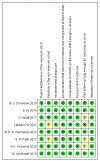Galectin-3 and Myeloperoxidase May Monitor Cancer-Therapy-Related Cardiotoxicity? A Systematic Review and Meta-Analysis
- PMID: 36551214
- PMCID: PMC9775944
- DOI: 10.3390/biom12121788
Galectin-3 and Myeloperoxidase May Monitor Cancer-Therapy-Related Cardiotoxicity? A Systematic Review and Meta-Analysis
Abstract
Galectin-3 and myeloperoxidase (MPO) are novel biomarkers in the field of cardio-oncology, but conflicting results have been reported. Hence, a meta-analysis was performed to assess the monitoring value of galectin-3 and MPO in cancer-therapy-related cardiotoxicity. PubMed, Cochrane, Web of Science, Embase, CNKI databases and ClinicalTrials.gov were queried. According to the predefined inclusion and exclusion criteria, eight studies with 1979 patients were included in this meta-analysis. The examination of the study's heterogeneity (I2), quality assessment and statistical analysis were performed by two reviewers. No significant differences in galectin-3 levels were noted before and after treatment (WMD = -0.10, 90% CI -6.06-5.85, I2: 99%), and a weaker relationship was observed between galectin-3 evaluations and cancer-therapy-related cardiotoxicity (HR = 1.39, 90% CI 0.97-1.98, I2: 0%). However, MPO levels were increased in patients post-treatment (SMD = 0.58, 90% CI 0.35-0.80, I2: 56%), and an increased risk of cardiotoxicity was associated with early pre-post MPO assessments (HR = 1.16, 90% CI 1.02-1.32, I2: 21%). Surprisingly, the MPO levels were a more effective indicator of the response to tumor treatment compared with the TnI (SMD = 2.46, 90% CI -0.26-5.19, I2: 96%) and NT-proBNP levels (SMD = 1.08, 90% CI -0.82-2.98, I2: 96%). In conclusion, our meta-analysis suggests that MPO may rep-resent a potential biomarker for the early detection of cardiotoxicity in current cardio-oncology practice, but the monitoring value of galectin-3 requires further study.
Keywords: biomarker; cancer therapy; cardio-oncology; cardiotoxicity; galectin-3; myeloperoxidase.
Conflict of interest statement
The authors declare no conflict of interest.
Figures







References
-
- Zamorano J.L., Lancellotti P., Rodriguez Muñoz D., Aboyans V., Asteggiano R., Galderisi M., Habib G., Lenihan D.J., Lip G.Y., Lyon A.R., et al. 2016 ESC Position Paper on cancer treatments and cardiovascular toxicity developed under the auspices of the ESC Committee for Practice Guidelines: The Task Force for cancer treatments and cardiovascular toxicity of the European Society of Cardiology (ESC) Eur. J. Heart Fail. 2017;19:9–42. doi: 10.1002/ejhf.654. - DOI - PubMed
-
- Patrizio L., Suter T.M., Teresa L.F., Maurizio G., Lyon A.R., Peter V., Alain C.S., Jose-Luis Z., Guy J., Marie M. Cardio-Oncology Services: Rationale, organization, and implementationA report from the ESC Cardio-Oncology council. Eur. Heart J. 2018;22:1756–1763. - PubMed
Publication types
MeSH terms
Substances
Grants and funding
LinkOut - more resources
Full Text Sources
Medical
Research Materials
Miscellaneous

